RTV molding is inexpensive and it can produce multiple copies of a part or pattern. In fact, it’s so flexible that even the most intricate and detailed parts can be reproduced. RTV molding is an affordable solution for prototyping, testing and product demonstration, which is perfect for short-run production.
The process for preparing a pattern and making a mold is similar to that of machine or injection molding. However, mixing and pouring RTV is a little different.

Here’s a step-by-step guide to mixing and pouring RTV:
- Calculate the amount of rubber needed for the mold. Subtracting the total cubic area of the pattern from that of the mold box will provide the correct amount of RTV needed.
- Prepare to mix the RTV. Hobbyists can use simple, wax-free cups or buckets. Companies typically have industrial equipment for this step of the process. As always, rubber or latex gloves and safety glasses are recommended.
- Find the right ratio. Generally, the RTV ratio is 10-parts rubber and one-part catalyst.
- Mix the RTV. This process requires slow, steady stirring as the catalyst is added to the rubber. The mixing process for RTV introduces spot-producing air bubbles into the mix. To avoid spots on the mold, most RTV rubber should be de-aired in a vacuum chamber at 29-inches of mercury for several minutes after it is mixed. If a vacuum chamber isn’t available, a layer of rubber can be brushed onto the pattern first.
- Pour the rubber. Start by slowly pouring the RTV into one corner of the mold. The rubber will start flowing, which is the cue to slowly raise the RTV about eight inches above the mold to create a steady flow into the mold. A slow, steady stream minimizes the chance of air bubbles making their way into the part.
- Cure it. It takes 24 hours for RTV molding to cure. Once it’s cured, remove the mold sides, then the pattern.
RTV molding is great for producing up to 25 prototypes from a single mold. For more information about the process, today.
